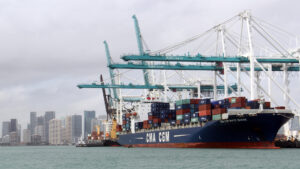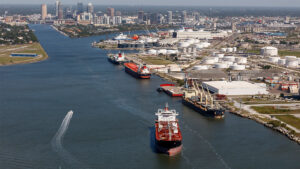This story was originally published by Grist. Sign up for Grist’s weekly newsletter here.
By Syris Valentine, Grist
Michael Diamond thought he’d have to wait until this year, at least, to have enough data to understand how a shipping regulation aimed at curbing pollution affected the clouds that deck the ocean. “They’re so variable. They’re so wispy. They’re so ever, ever changing,” he said. “So you really often need a lot of observations to get at what they’re doing.”
Nonetheless, just three years after the international maritime community slashed sulfur emissions in 2020, the cloud physicist with Florida State University published an award-winning paper studying clouds along a shipping lane in the southeast Atlantic. By analyzing satellite data from before and after the regulation took effect, Diamond demonstrated that the clouds had dimmed. In other words, even as it cleaned its emissions, the global shipping sector made marine clouds a little less bright.
This change carries important implications for the planet. It means less sunlight is reflected back into space — which means more warming.

That effect extends well beyond the isolated shipping lane Diamond studied. Others have detected it worldwide in the years since the International Maritime Organization adopted the rule. The regulation, shorthanded as IMO 2020, cut the maximum level of sulfur in shipping fuels for all vessels, container ships, and cruise ships alike, from 3.5 percent to 0.5 percent with the goal of cleaning the air in ports and the communities around them, potentially saving hundreds of thousands of lives each year.
It worked. Measurably lower levels of ammonia and sulfur dioxide dirty the air around many ports, and the majority of shipping fuel tested by the organization comply with the limits. Yet, it’s had the unintended consequence of ramping up near-term global warming.
How much hotter things are going to get remains an open debate.
“I think there’s going to be a lot of papers on the shipping emission reductions,” said Robert Allen, a climate scientist from University of California Riverside with expertise in aerosols. “I don’t think they’re all necessarily going to be arguing the same thing.”
Aerosols, which are short-lived pollutants suspended in the atmosphere, introduce more uncertainty into climate models than any other variable. One of the most common comes from sulfur. Unlike its carbon cousin, sulfur dioxide tends to cool the planet by creating aerosols that reflect sunlight while also making clouds brighter. When industries around the world emit fewer of these pollutants, clouds darken. The planet absorbs more sunlight, and land, air, and water heat even faster than before.
At the end of May, Tianle Yuan, an atmospheric scientist with NASA’s Goddard Space Flight Center, published one of the first papers to use observational data and climate models to determine what this means for Earth. The results were stark and startling.
Until now, temperatures have typically climbed almost a fifth of a degree Celsius, on average, per decade since 1981 — just over a third of a degree Fahrenheit. Yuan’s results suggest that, over the next decade, the sharp decrease in ocean aerosols will cause temperatures to rise an additional quarter of a degree Celsius. “This decade, we expect the warming rate to be more than double,” Yuan said, “if our calculation is right.”
But, as happens in science, not everyone agrees that he and his collaborators got it right.
Robert Allen, for one, believes that Yuan and company went astray. He and his colleagues conducted a study of their own (it is awaiting peer review), and though they agree with Yuan on how the regulation affected the amount of light the Earth receives, they came “to some different conclusions.”

“We get less than 0.05 degrees,” Allen said, “over the next 20 years.” In fact, as he and his coauthors noted, their range of results is consistent with “no discernible” impact on global temperatures. The discrepancy between the two results, Allen indicated, comes down to how they simulated the impact.
At their core, the differences between Allen’s results and Yuan’s boils down to a difference in modeling. Yuan relies on an energy balance model, which makes simplifying assumptions about the planet to calculate the temperature change associated with a given force on the climate. Allen, on the other hand, used an Earth system model, which attempts to include more realistic representations of Earth’s climate as it seeks to predict how changing the composition of the atmosphere will affect temperature, among other things.
A third study by a pair of Cornell researchers also leveraged an Earth system model and came away with results that largely align with Yuan’s. The difference here can be explained, at least in part, by the number of “ensemble members” used. Simply put, each member of the ensemble represents the same model run using slightly different initial conditions, an approach that allows scientists to explore the myriad ways that even small factors might push the climate in different directions. Think of it as a way of attempting to account for the butterfly effect. A large ensemble, then, allows researchers to separate the signal from the noise and discern the actual impact that something like IMO 2020 produces.
Modeling differences aside, a more modest impact seems more reasonable. As both Allen and Diamond pointed out, if all the aerosols in the world suddenly vanished, the planet would warm by at least half a degree Celsius and, at most, just over 1 degree. And though IMO 2020 cut maritime sulfur emissions by almost 80 percent, shipping was responsible for less than 10 percent of global emissions of the pollutant even before the regulation was adopted. That means even deep cuts in that sector should produce a limited response.
Ultimately, though — with some suggesting that warming will double this decade as others point toward only a minor increase — Allen said, “the science isn’t closed.” As a result, the current debate tells us less about the specific effects of cleaning up shipping pollution and more about the potential dangers of eliminating aerosols without also addressing greenhouse gases.
No one doubts that cutting sulfur emissions benefits public health. One study published in 2016 found that instituting the cap on sulfur emissions in 2020 would prevent at least 570,000 premature deaths over the following five years. But given that sulfur also cools the planet, failing to rein in, at the very least, short-lived greenhouse gases like methane while reducing sulfur pollution simply ratchets up the rate at which the world warms.

Cutting carbon dioxide is, of course, critical. But it can linger in the atmosphere for a millennium. Aerosols, on the other hand, fall from the sky within weeks, which means the incidental cooling effect they produce doesn’t stick around long after emissions of them end — even as airborne carbon continues to capture heat. Luckily, when combined, the greenhouse gases methane and groundlevel ozone warm the planet as much as aerosols cool it. And they don’t last nearly as long as CO2 does. Low-lying ozone persists for a few weeks at most, and methane disappears within a decade.
So, eliminating those pollutants alongside aerosols could negate any abrupt warming that might otherwise occur. “But that’s opposite what’s happened,” Allen said. Not only has ship-emitted sulfur all but vanished, China has gone to great lengths to clean its air at a pace faster than any expected. Meanwhile, carbon emissions have continued to swell around the world. Yuan and many others argue that this has created a “termination shock,” leading to an abrupt rise in global temperatures with additional effects that reach beyond heat. Eliminating aerosols without an associated decline in greenhouse gases has the potential to worsen wildfire activity in boreal forests, slow an essential ocean current, and affect regional weather patterns in ways not yet understood.
All of this has led seven climate advocates and researchers to pen an open letter to the International Maritime Organization. They urge it to consider allowing vessels to burn dirtier fuel on the high seas, far from population centers, to “increase the global cooling benefits of sulfur or similar aerosols without causing harm to humans or natural systems.” They also ask the organization to support research and testing of technologies that would enable ships to, for instance, create salt aerosols from sea water and spray them into the air to get the benefits of brighter clouds without the side effects of sulfur.
Although a spokesperson for the International Maritime Organization said it welcomes reports and research from most anyone, it only considers regulations when they are raised by member states. So whether the open letter will have any impact remains to be seen. The dispatch nevertheless represents an early rumble of what many scientists fear may become a clamor to engineer the planet in increasingly dramatic and deliberate ways as the climate crisis intensifies.
Such calls aside, the inadvertent impact of IMO 2020 — to say nothing of climate change itself — makes it clear that humanity has long manipulated the atmosphere. But the debate between Allen, Yuan, and their colleagues poses the fundamental question of how any technologist can hope to engineer a precise degree of purposeful cooling when scientists can’t even agree on the exact impact of our accidental experiment.
This article originally appeared in Grist at https://grist.org/science/how-cleaning-up-shipping-cut-pollution-and-warmed-the-planet/.
Grist is a nonprofit, independent media organization dedicated to telling stories of climate solutions and a just future. Learn more at Grist.org.
Sign up for The Invading Sea newsletter by visiting here. If you are interested in submitting an opinion piece to The Invading Sea, email Editor Nathan Crabbe at ncrabbe@fau.edu.



